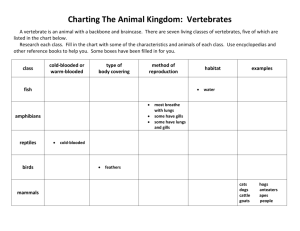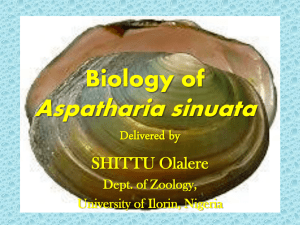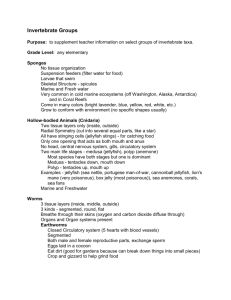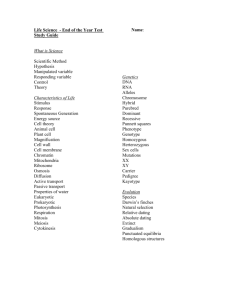Osmoregulation and the Gill Na+-K+
advertisement
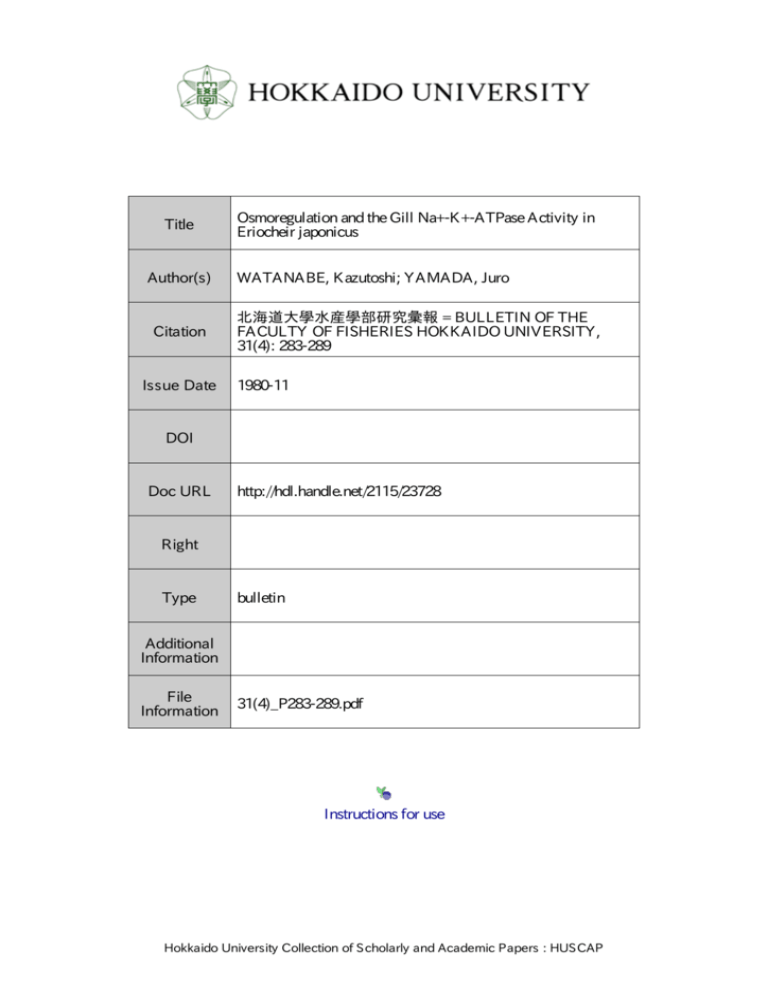
Title Author(s) Citation Issue Date Osmoregulation and the Gill Na+-K+-ATPase Activity in Eriocheir japonicus WATANABE, Kazutoshi; YAMADA, Juro 北海道大學水産學部研究彙報 = BULLETIN OF THE FACULTY OF FISHERIES HOKKAIDO UNIVERSITY, 31(4): 283-289 1980-11 DOI Doc URL http://hdl.handle.net/2115/23728 Right Type bulletin Additional Information File Information 31(4)_P283-289.pdf Instructions for use Hokkaido University Collection of Scholarly and Academic Papers : HUSCAP Bull. Fac. Fish. Hokkaido Univ. 31(4), 283-289. 1980. Osmoregulation and the Gill Na+-K+-ATPase Activity in Eriocheir japonicu8 Kazutoshi WATANABE* and Juro YAMADA* Abstract Osmoregulation of Eriocheir japonieU8 in media of varying salinities was investigated. The crabs exhibited a hyper- and hyposmoregulatory ability. The osmotic concentration of the hemolymph was isosmotic when they were acclimated to 80% seawater. The hemolymph sodium concentration showed the same change as did the hemolymph osmotic concentration. The specific activity of Na+-K+-ATPase in the anterior gills was higher in crabs acclimated in 120% seawater than those maintained in freshwater, while the activity in the posterior gills was higher in freshwater carbs than in 120% seawater crabs. It was suggested that salt extrusive mechanism may be localized in the anterior gills and a salt absorptive mechanism in the posterior gills. Many crab species that inhabit waters of changeable salinity have the ability more or less to regulate their hemolymph osmotic concentration. Sodium is one of the major osmotically active components in the hemolymph and its regulation is important for the osmoregulation. It has been known that crab gills are capable of active abosrption1)2)3)4) or extrusion 5 ) of sodium ions, and that Na+-K+-ATPase activity in the gills plays an important role in the process of osmoregulation in crabs6 )7)8)9) • Since Eriocheir japonious lives in freshwater and undergoes a dramatic osmotic change during the spawning migration from freshwater to seawater, this crab may be a strong osmoregulator. This study was designed to investigate the ability of osmoregulation in E. japonious. The osmotic and sodium concentrations of hemolymph were analysed by acclimating the crabs to salt depleted or loaded conditions. Changes of the gill Na+-K+-ATPase activity were examined under the extreme osmotic conditions. Materials and Methods Intermolt crabs of Eriocheir japonious, 20-40 mm in carapace width, were collected from rivers near Hakodate, Hokkaido, and maintained in freshwater at 15°C. Animals were exposed to a variety of concentrations of artificial seawater (35, 70, 80, 90, 100 and 120% SW) for 1 to 25 days. The experimental media were prepared by appropriate dilution or concentration of the van't Hoff's formula. Mter exposure, hemolymph was collected from 3 to 9 animals at each time by cutting a walking leg and dripping hemolymph into a test tube. Mter crushing clotted hemolymph with a micro-spatula, it was centrifuged at 3000 X g for lO min, • Laboratory of PkyBiology and Ecology, Faculty of Fi8herie8, Ho'kkaido Uni'l}erBit1! (:It;d*~*&:~mu~~.~&) -283- Bull. Fac. Fish. Hokkaido Univ. 31(4). 198Q. The resultant serum was used for the determinations of osmotic and sodium concentrations. The serum osmotic concentration was determined by the freezingpoint method using an osmometer (Precision System, :Model 2007). Sodium was measured by flame photometry using an atomic absorption spectrophotometer (Hitachi, Model 518). . The gill Na+-K+-ATPase activity was assayed with animals maintained in freshwater and those acclimated in 120% seawater for 20 days. The six pairs of gills, except the vestigial gills, were excised separately in three anterior and three posterior pairs. The gills were homogenized in 20 vol. (V/W) of 0.3M sucrose containing 5 mM EDTA·2Na and 100 mM imidazole (pH 7.2). The homogenate was centrifuged at 500xg for 10 min and the supernatant was used· for total and ouabain insensitive ATPase (Mg2+-ATPase) assays. A 0.1 ml sample was added to 0.4 ml ofthe reaction medium which contained 100 inM NaCI, 20 mM KCI, 6 mM MgCIs, 6 mM ATP.2Na and 100 mM imidazole (pH 7.2), either with or without 1 mM ouabain, and preincubated at 37°C for 5 to 10 min before the sample was added. The reaction mixture was incubated at 37°C for 20 min. Enzymatic reaction was terminated by adding a 10 ml ice-cold iron-TCA reagent10). Inorganic phosphate (Pi) liberated from the substrate was measured by the method of Goldenberg and Fernandez10). Na+-K+-ATPase activity was calculated from the difference between total and Mg2+-ATPase activities. Protein of the sample was measured by the method of Lowry et a1.11 ) using bovine serum albumin· as a standard. Results Time course changes of hemolymph osmotic concentrations after transfer to media of various salinities are illustrated in Fig. 1. The hemolymph osmotic concentration of freshwater crabs was 658 mOsm/kg. When the crabs were transferred to 35% seawater, it immediately reached a stable level of 69~732 mOsm/ kg that was considerably hyperosmotic to the medium. In 70% seawater, the hemolymph value appeared to become stable on and after day 10, measuring 733800 mOsm/kg, somewhat hyperosmotic to the medium. The hemolymph value was isosmotic to the medium in 80% seawater after day 20 and measured 813-816 mOsmfkg· In 90% seawater, the hemolymph osmotic concentration was stabilized after day 10 and measured 855-913 mOsm/kg which was isosmotic or slightly hyposmotic to the medium. In 100% seawater, it measured 914-959 mOsm/kg after day 15, an apparently lower level than that of the medium. The hemolymph concentration hyposmotic to the medium was also observed in 120% seawater. The final level was between 1003 and 1059 mOsm/kg after 20 to 25 days. It was shown that hemolymph of E. japonicus was isosmotic to the medium in 80% seawater, hyperosmotic in more diluted seawaters and hyposmotic in those more concentrated, after acclimation. The period required for acclimation to media took at most 20 days. Changes of the sodium concentration of hemolymph in relation to that of the media are shown in Fig. 2. Generally, the level of hemolymph sodium paralleled the changes of the osmotic concentration. In 35% seawater, the hemolymph -284- WATANABE· & Y AlIfA1>A: Osmoregulation in Erioche... 1500 - 100% SW 1000 ... 80% SW "'......e" 1/1 o e - - Seawater - 500 Hemolynph in • FW • <> It. A I 35% 80% 100% 120% SW SW SW SW 3S%SW I o1 3 6 10 15 20 25 Days after transfer Fig. 1. Changes of the hemolymph osmotic concentration of freshwater crabs after transfer to various salinities. Bars represent standard deviations for 3-9 smaples. Dashed lines represent the level of each experimental medium. consistently showed a constant level of about 350 mEq/1 that was considerably hyperionic to the medium. In 70% and 80% seawater, hemolymph sodium finally reached nearly isoionic levels after 15 or 20 days, measuring 349-359 mEq/1 and 392-432 mEq/l, respectively. The hemolymph was hypoionic to the media in 90%, 100% and 120% seawater, measuring 396-452 mEq/1 after day 10, 432-472 mEq/1 after day 15 and 490-536 mEq/1 after day 20, respectively. Similar to the case of osmotic concentration, it also took about 20 days at most for the hemolymph sodium concentration to adjust to a stable level. The correlation between osmotic concentrations of the medium and of the hemolymoph 20 days after transfer is shown in Fig. 3. The curve crosses with the isosmotic line at point 816 mOsm/kg, that is equivalent to 80% seawater. Below or above this point, the hemolymph turns hyper- or hyposmotic to the medium. The same correlation is also found for sodium concentrations (Fig. 4). This indicates that E. japonicus is a hyper- and hyposmoregulator and that osmoregulation largely depends on the sodium regulatory mechanism. The specific activity of gill Na+-K+-.ATPase was determined with animals maintained in freshwater and those acclimated in 120% seawater for 20 days (Fig. 5). In freshwater crabs, the enzyme activity of the posterior gills (7.27 ,aM Pi/mg proteinfhr) was twice as much as that of the anterior (3.34 ,aM Pi/mg protein/hr). In 120% seawater acclimated crabs, however, no difference was found between -285- Bull. Fac. Fish. Hokkaido Univ. 31(4). 1980. 700 - - - - - - - - - - 120% SW 600 ":""'",,--iT- 500 100% SW 80% SW 400 "....e 300 C" --Seawater Hemolymph in • FW • 35% SW o 80% SW - - - - 35% SW • 100% SW '" 120% SW 200 100 o1 3 6 15 10 20 25 Oays after transfer Fig. 2. Changes of the hemolymph sodium concentration of freshwater crabs after transfer to various salinities. Bars represent standard deviations for 3-9 samples. Dashed lines represent the level of each experimental medium. 1500 0. ~ 600 Ul 'il 1000 / /// 200 '"------1.-----1.---. ... 500 0 ..... o 1000 1500 Medium (mOsm/kg) / / 0 0 / / / 200 400 600 Medium (mEq/m1) Fig. 3. Correlation between the osmotic concentrations of the hemolymph and the medium 20 days after transfer. Dashed line represents the isosmotic line. -286- Fig. 4. Correlation between the sodium concentrations· of the hemolymph and the medium 20 days after transfer. Dashed line represents the isoionic line. WA.TANABE & YAMA.I>A.: Osmoregula.tion in ~ir the anterior and posterior gills. The specific activity of the anterior. gills was significantly higher in 120% seawater crabs (4.36,aM Pi/mg proteinfhr) than in freshwater ones. However, the enzyme activity of the posterior gills was Anterior significantly higher in freshwater 10 crabs than in 120% ones (5.08 ,aM • Posterior Pi/mg protein/hr). o .. .2 Discussion ..... of eCo E. japonicus exhibited an ability C/I 5 ~ of hyper- and hyposmotic regulation 0:: over a wide range of salinities investigated. This type of osmoregulation has been reported in Artemia salina12 ), PalaemOMtes varians13 ), Pachygrapsus crassipes14), E. sinenSis 15 ) and some other crustaceans16 ). 120% SW FW Most of these animals live in environFig. 5. Na.+·K+·ATPase activities of the ments of fluctuating salinity such anterior and posterior gills of crabs as intertidal zones and inland saline acclimated to freshwater or 120% waters. Although E. japonicus does seawater. Bars represent standard deviations for 5-9 samples. not consistently live in such environments, especially in high salinity, they do undergo a fluctuation of salinity during the spawning and larval periods. The higher Na+-K+-ATPase activity of the posterior gills in freshwater crabs compared to that in 120% seawater crabs suggests that a sodium absorptive mechanism may be located in these gills. An elevation of Na+-K+-ATPase activity in the posterior gills at low enviropmental salinities was reported in Carcinus maenasl7 ), E. sinensisS) and Thalamita crenata9 ). Towle et a1.7) found an increase in the Na+-K+-ATPase activity in the whole gills of CaUinectes sapidus when transferred to diluted seawater. This may be due to an increase of the enzyme activity in the posterior gills. Metopograpsus thukuhar, though it is a hyper- and hyposmoregulator, exceptionally showed no change of the gill Na+-K+-ATPase activity through a range of 25-100% seawater9). Active absorption of sodium was demonstrated in the gills of C. sapidusl) 4) and in the 3 pairs of posterior gills of E. sinensisl)3). Furthermore, salt absorbing cells were morphologically identified in the posterior gills of C sapiduslB) and Gecarcinus 'lateraZis19 ). On the other hand, the higher activity of Na+-K+-ATPase of the anterior gills in 120% seawater crabs may suggest the localization of sodium extrusive ability. Augenfeld20 ) found that Na+-K+-ATPase activity in A. salina increased with the elevation of environmental salinity. Sodium extrusion from crustacean gills was shown in Uca pugiZator5) , U. pugnax 5 ), A. salina21 ) and Parartemia zietzianall ). Copeland23 ) and Flemister4 ) demonstrated morphologically the presence of salt secreting cells in the gills of A. -t287- Bull. Fac. FiSh. Hokkaido Univ. 31(4). 1980. sti.linaand OciJpOde albicans. In contrast to these, Da1l1l5) claimed that in sonie decapods excess sodium is secreted via the digestive tract and not the gills. Green et a!. 6) also suggested that the digestive tract may function in sodium secretion in U. pugilntrw. . The results of the present study showed that E. japoniOus is a hyper- and hyposmoregulator. Change of the gill Na+-K+-ATPase activity suggested that the posterior gills may playa role in sodium absorption in freshwater and hyposmotic conditions while the anterior gills participate in sodium extursion in hyperosmotic conditions. References 1) Koch, H.J. (1954). Cholinesterase and active transport of sodium chloride through the isolated gills of the crab Eriocheir Binen8i8 (M. Edw.). ColBton Paper8. 7, 15-27 2) Mantel, L.H. (1967). Asymmetry potentials, metabolism and sodium fluxes in the gills of the blue crab, Callinectes 8apid'U8. Compo Biochem. PhyBiol. 20, 743-753. 3) King, E. and Schoffeniels, E. (1970). Osmoregulation in aquatic arthropods. p. 21»-. 286. In Florkin, M. and Scheer, B.T. (ed.), Chemical Zoology. V. Arthropoda Part A. 460p. Academic Press, New York and London. 4) Smith, D.S. and Linton, J.R. (1971). Potentiometric evidences for the transport of. sodium and chloride across excised gills of Callinectes sapid'U8. Compo Biochem. PhyBiol. 39A, 367~378. 5) Green; J.W., Harsh, M., Barr, L. and Prosser, C.L. (1959). The regulation of water and salt by the fiddler crabs, Uca pugna,x and U. pugiiaIor. Biol. Bull., Woods Hole 112, 34-42. 6) Quinn, D.J. and Lane, C.E. (1966). Ionic regulation and Na+-K+ stimulated ATPase . activity in the land crab CardiBoma.guanhumi. Compo Biochem. PhyBiol.19, 533-543 .. 7) Towle, D.W.,. Palmer,. G,E. and Harris, J.L. (1976). Role of Na++K+-dependent ATPase in acclimation of blue crabs (Callinectes 8apid'U8) to low salinity. J. ezp. Zool. 196, 315-322. 8) PAquex, A. and Gilles, R. (1977). Osmoregulation of chinese crab Eriocheir BinmBiB . as related to the activity of the (Na+, K+) ATPase. Arch8 into PhY8iol. Biochim. 85, 426-428. 9) Spencer, A. McD., Fielding, A.H. and Kamemoto, F.I. (1979). The relationship between gill NaK-ATPase activity and osmoregulatory capacity in various crabs., PhyBiol. Zool. 52, 1-10. :10) Goldenberg, H. and Fe~andez, A. (1966). Simplified method for the estimation of inorganic phosphorus in body fluidS. CUn. Chem. 12, 871-882. 11) Lowry, O.H., Rosebrough, N.J.,' Farr, A.L. and Randall, R.J. (1951). Protein measurement with the Folin phenol reagent. J. bioi. CMm. 193, 265-275. 12) Croghan, P.C. (1958). The osmotic and ionic regulation of Artemia salina (L.). J. ezp. BioI. 35, 219-0-233. ' 13) Parry, G. (1955). Urine production by antennary glands of Palaemonetes vanans Leach. Ibid. 32, 408-422. ' .' 14) . Gross, W.J. (1957). An analysis of response to osmotic streBB in selected decapod crustacea. Biol. BUll., Wood" Hole 112, 43-62. 15) Conklin, R. and Krough, A. (1938). A note on the osmotic behaviour of Eriocheir in concentrated and Mytil'U8 in dilute seawater. Z. vergl. PhyBioI. 26, 239-0-241. 16) Lockwood,.A.P.M. (1962). The osmoregulation of crustacea. Bioi. R6t1. 37,257-305. 17) Mantel, L.H. and Landesman; J. (1977). Osmotic regulation and Na+K-activated , ATPase in the green crab, Carein'U8 mamwB and the spider crab Libinia emarginata. Biol. BUll., Woods Hole 153, 437-438. - 288"- WATANABE & YAMADA: Osmoregulation inEriocheir 18) Copeland, D.E. and Fitzja.rell, A.T. (1968). The salt absorbing cells in the gills of the blue crab (Callinect68 8apidU8 Rathbun) with notes on modified mitochondria.. Z. ZellJor8Oh. 92, 1-22. 19) Copeland, D.E. (1968). Fine structure of salt and water uptake in the land crab GecarcinU8 laterali8. Am. Zool. 8, 417-432. 20) Augenfeld, J.M. (1969). The role of Na+-K+-activated ouabain sensitive ATPase, in the response of Arlemia Balina L. to salinity changes. Life Sci. TI. 8, 973-978. 21) Croghan, P.C. (1959). The mechanism of osmotic regulation in Artemia Balina (L.): , the physiology of the branchiae. J. expo Bioi. 35, 234-242. 22) Geddes, M.C. (1975). Studies on an Australian brine shrimp, Pararlemia zietziana Sayee (Crusta.cea: Anostraca)-ill. The mechanisms of osmotic and ionic regulation. Cqrnp. Biochem. PhyBiol. 51A, 573-578. 23) Copela.nd. D.E. (1967). A study of salt secreting cells in the brine shrimp (Arlemia 8alina). ProtoplaBma 63, 363-384. 24) Flemister, S.C. (1959). Histophysiology of gill and kidney of the crab Ocypode albicanB. BiOI. BuZl., WooclB Hole 116, 37-48. 25) DaIl, W.(1967). Hypo-osmoregulation in crusta.cea. Cqrnp. Biochem. Physiol. 21, , 653-678. -i89-
